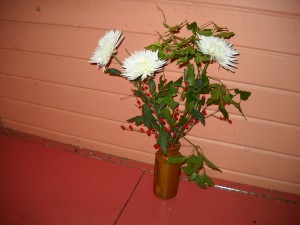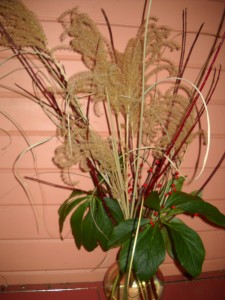Using Found Plant Material to Decorate the Holiday Home
Once again, my garden is just about out of steam. Winter is upon us – not by the calendar – but with temperatures dropping into the low 20’s recently, I say it’s winter. It’s no longer possible to step outside and fill a vase with my own flowers. The only flowers still blooming are my intrepid Johnny Jumps-Ups (Viola tricolor). At one time or another they have bloomed for me every month of the year. That’s right, if we have a January or February thaw, the Johnny’s may well bloom. But still, I long for more variety.
As a freelance writer, I don’t have a big budget for cut flowers. But I do believe in buying a few stems to brighten the table on a regular basis. Recently I bought 3 stems of what are called “spider mums’ for a total of just $4.50. I then went outside to see what I might add to these flowers to fill up the vase. There is a remarkable amount of useable material outside, both in the garden and in the wild.
The general rule of thumb is that an arrangement should be two to three times the height of the vase. I selected an 8-inch vase, and cut the mums down to about 20”. The mums are white, so to add color I cut some stems of winterberry (Ilex verticillata). Winterberry is our native deciduous holly plant that flaunts bright red berries at this time of year. They are commonly sold landscape plants but also grow wild in wet places along the road. They grow 4-12 feet tall; the stems I cut were about 3 feet long, and branched.
I decided to cut off 12-inch side shoots and use them to form the lower portion of the arrangement. I put the tall mums in the center of the vase and their green leaves added a contrasting color and filled out the space between the blossoms and the berries. I also added a section of a clematis vine for more greenery.
At this time of year I crave greenery, so I was delighted to notice nice glossy leaves on my fall-blooming clematis (Clematis paniculata), a vine that I grow on a trellis. I had never before picked a vine to use in a vase, but it worked well. Vines, I just discovered, are wonderful in an arrangement: they are flexible and can be woven through stalks of tall stiff flowers or shrubs.
Next I went outside to collect things that are totally free for a second arrangement. I grow Lenten Rose (Helleborus orientalis), an early spring-blooming plant with glossy, evergreen leaves. Each leaf consists of 5-9 oval leaflets attached to a central point; each group of leaflets is a foot or so in diameter. By spring this year’s leaves will be ratty looking, but now they still looked good. I selected 4 leaves to establish a visual base for the arrangement. They looked good in the vase for about 5 days.
Lacking Lenten rose, I could have used white pine branches for some greenery, or balsam fir or spruce branches. I know better than to use Canadian hemlock in a vase, even though I have plenty of it, because it drops its short, soft needles after just a few days.
Next I cut six 24-inch stems of redosier dogwood (Cornus sericea) and added them to the 10-inch tall, wide-mouthed vase. I grow this shrub mainly for its look in winter. The first-year stems turn bright red in winter, standing out proudly above the snow. Second-year stems (and older) turn a darker, brownish color, so cutting some stems each year keeps the shrub looking at its best. Redosier dogwoods prefer moist soil, but will grow almost anywhere – including alongside the road.
Lastly, I cut stems of a tall decorative fountain grass (Miscanthus sinensis) and added them to the arrangement. Decorative grasses have become very popular in the landscape design business, but not all perform well after year one. They generally like lean, well-drained soil and my soils tend to be rich and moist, but some years I have some very dramatic 6-foot tall plants that look good for most of the winter. I have plenty right now.
If you don’t have a decorative grass with seed heads to use in an arrangement, you might be tempted to pick some stems of the common reed whose Latin name is Phragmites australis. It is commonly seen alongside the road in wet places. It can grow to 10 feet tall, and is very dramatic. The pretty part of the plant consists of big fluffy seed heads (on tall stems). But if you do use it, don’t throw the seeds in your compost pile because the plant can be invasive. Burn the seed heads when done with the arrangement – even though I’ve read that that the plants spread mainly by root.
So don’t despair if your flowers have all gone away. Just go outside with your scissors and a pair of pruners. There are plenty of other interesting stems that are free for the taking.
Henry Homeyer’s new book is called Organic Gardening (not just) in the Northeast: A Hands-On, Mo nth-by-Month Guide. His Web site is www.Gardening-Guy.com. Reach him by e-mail at henry.homeyer@comcast.net




